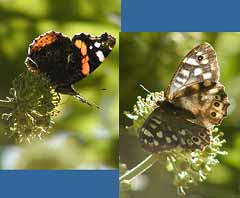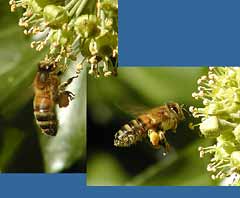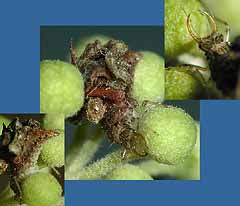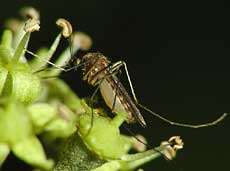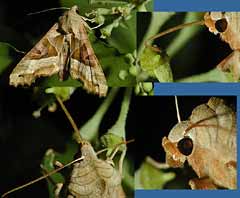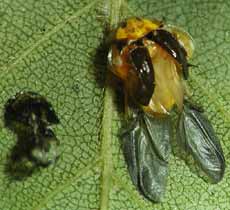Go to last entry of the month.............. ......Go to previous entry16 September - Summer continues with yet another sunny day with the temperature up to 27C. The down side of all this good weather is that the ground is very dry. The work at the bottom of the garden and in one spot where I have dug done a couple of feet the ground is still dusty dry. The work has been interrupted throughout the morning and afternoon as I finally had the chance to watch the emergence of an Orange Ladybird from its pupa.
Around 9.32am the pupa started to move about (3). At 9.39am a slit appeared down the centre of the head region (4-6) and by 9.41am the ladybird's head was exposed. The split in the pupa skin gradually spread backwards (7-10) and the rest of the ladybird appeared. Finally, it had emerged completely at 9.56am. After only a brief pause the ladybird turned round (12) and climbed onto the outside of the moult (13).
They remained extended until I noticed that the ladybird was starting to retract them (at 11.34am) very slowly (15-17) until they finally disappeared under the elytra at 11.52am (18). Everything came to an apparent halt then until 3.37pm when it suddenly sprang into action with a bit of leg stretching (19-20) and a minute later it walked away.
The second sequence shows how the colour of the ladybird darkened over the 5hr 42min sine it first emerged.
Finally, an image of the ladybird as it left the leaf and headed off into the rest of the tree.
Click on the images to see larger versions
Later this afternoon I was out in the driveway when Sheila called me to look at a moth visiting our Buddlea plant (only a few flowers left now). By the time I got to her the moth had gone, but Sheila's description fitted closely a Hummingbird Hawk Moth. I found some pictures on the web and they confirmed the sighting for Sheila - and I missed it!
First of all, this is a follow-up picture of the ladybird featured above. The picture was taken late in the evening on the 17th and shows how much it had darkened in the day following the emergence. It seems that with 14 spots instead of the usual 16 (or 12) spots this is a quite unusual example of the Orange Ladybird.
The Ivy flowers started opening yesterday, although there are only a few open so far and I haven't see more than a couple of bees visiting today. It should get busy at the Ivy tree in the next week, especially when the sun shines. Today it was dull and overcast most of the time, but there is still no sign of rain for us. Where I dig in the dry soil I am finding earthworms that have burrowed down and seem to be curled up and in a state of dormancy (known as Estivation) while they wait for moisture levels to rise.
21 September - As the good weather continues I have been trying to get ahead with the work at the bottom of the garden, although I'm finding it hard going at the moment.
There have also been some daytime visits by Speckled Wood butterflies.
After dusk a check of the Ivy revealed some moths feasting on the nectar. I haven't identified this one yet. In the main image you can see its proboscis reaching down as it feeds.
This second type is one of the Plume Moths, with its characteristic thin, feathery wings. The close-up image shows its long, slender proboscis reaching to the nectar.
Unlike the moths and butterflies, the lacewing does not have a long proboscis to collect its food and has to get in close to the flower surface as shown in the left image. Their presence is interesting as they are predatory, normally more interested in greenflies and other small insects, although here they were more interested in the flowers.
While I was taking these pictures there was the unmistakeable sound of a Heron flying over. I wonder if it had been disturbed while roosting.
Finally, a picture from the late afternoon when this dragonfly (A Southern Hawker - I think) flew up onto our verhanda and rested for a short time. The main image shows a moment as it turned its head to presumably wipe over the eyes with a front leg.
Click on images to see larger versions
22 September - Rain Stopped Play! The summer came to a sudden halt today as rain moved in from the north. Squally, heavy showers meant that by the end of the day a water butt that I set up yesterday was over half full by this evening. Sheila and I went for a drive this afternoon to get some embroidery bits for her and on a country road we found our way blocked by a tree, fallen as a result of the weather. The wind also emphasised that Autumn is coming as it blew lots of leaves off the trees and at one spot during our journey, judging by the noise on the windscreen and roof of the Land Rover, there were also acorns falling.
By sunset the rain had more or less stopped and the sun was able to peep under the cloud base to give us a couple minutes of redness before darkness fell. The picture shows the view from our bedroom window.
23 September - Back to blue skies today, although the temperature has now dropped from highs of around 25C or more to just 15C at one time this morning. Tonight we resorted to eating inside - a rare event since the beginning of the Summer.
Although some earthworms are active there are others like this one, still curled up in a state of Estivation - uncovered as I did some more digging. The work took another big step forward this afternoon when my other tree surgeon son (Simon) turned up with his stump grinder to finally clear away the remains of the Leylandii. Now I must prepare the ground ready to move the birdbox to its new location. While I was at the bottom of the garden my attention was drawn to a loud tapping from low down in a shrub in my neighbour's garden. Although I could see a branch moving, the cause remained out of sight from me, and by the time I returned with the camera it had gone. Sheila and I heard the sound again a couple of times at lunchtime. Despite it being in our garden this time I still failed to see anything. It sounded exactly like a woodpecker.
There is a chilly start to each morning now.
While I was checking my e-mails before breakfast I heard the tapping mentioned yesterday. This time it came from my neighbour's side of the fence behind our Hawthorn. I went outside to listen and watch but although it continued for a minute or so I didn't see anything emerge, so that puzzle continues. Something I forgot to mention yesterday was the appearance at the feeder of a solitary Goldfinch, the first one I've seen here for ages ( last diary record was November 2001). This morning there were a couple of yellowy-green Warblers hunting for insects on the large Bamboo plant by my shed. There was no opportunity to get photographs and I'm not sure whether they were Chiffchaffs or Willow Warblers.
The bright sunshine brought early visitors to the Ivy with several Red Admirals and Speckled Woods feeding. As usual the Red Admirals are being awkward and only choosing the higher flowers.
The most numerous visitors to the Ivy are these bees - the sound of their buzzing is obvious when you approach the tree.
Click on images to see larger versions
This afternoon I spent a bit of time making a long overdue modification to the Olympus camera so that I can use an angle finder that will allow easier use of the camera for low level photography as well as shots at awkward angles when it is difficult to either look through the viewfinder or use the LCD screen. I have added to the Technical page a section about the change. When I went outside to try out the new arrangement I disturbed a bird in my neighbour's garden. I didn't see it but I think its call sounded like that of a Woodpecker.
27 September - As dry weather continues I have been distracted by the work down the garden these last few days so the wildlife has not had much attention. However there are a few things to note. First of all, yesterday I had a close encounter with the local Sparrowhawk (female- I think) dived into the Hawthorn and emerges with a Sparrow in its clutches. Its outspread wing passed below my outstretched arms as it headed out of the garden.
My first impression is that it may be the larva of a lacewing. These feed mainly on aphids and then use the empty skins to camouflage themselves. To give an idea of scale, the flower buds measure about 3.5mm across.
Tonight I couldn't see any lacewings, but there are plume moths again and a number of mosquitoes which, like this one (a female?), were obviously gorging themselves on the nectar. While mosquitoes are usually thought of as blood sucking insects (the females, that is), I understand that both sexes drink nectar as a source of energy for flight. Click on the images to see larger versions Unusually, I seem to have got through this Summer with hardly any mosquito bites and there have been none taking an interest in me as I spend time by the Ivy. I see a hedgehog in the garden most nights and tonight it was busy eating chopped peanuts under the Hawthorn when I went down the garden.
30 September - The last few days have flown by as I have shared my time between the continued work down the garden and copying old family photographs, so I'm afraid the camera has been largely idle.
I did take the camera down to the Ivy tree two nights ago to record this moth feeding on the nectar. It is an Angle Shades moth (Phlogophora meticulosa) - a common moth with wings that seem to crumple up when it is at rest.
As the picture shows, the ladybird succeeded in emerging from the pupal skin but its elytra (hard front wings) were badly deformed and the hind wings are unusually dark. When I returned about 15 minutes later it had disappeared. I searched the adjacent branches and leaves but there was no sign of it - I fear it had fallen off the leaf. Elsewhere on the Birch tree two other ladybirds also emerged today and both looked healthy. Other active adults can be seen in the tree and there are still a couple of pupae in the tree. Time is now getting short for them as the leaves are starting to change colour. On the Hawthorn, leaves are already being shed. On the 6th September I noted that Collared Doves were nest building following their mating. Six days ago I found a white shell fragment in the garden and I wonder if that was a sign of a hatching in the nest, or whether the nest had been raided. I have seen the Doves going to the next site since that day so it is possible that there is a chick in the nest |
|
2003 Garden Diary Index..........Last Month.......bNext Chapter (October) |
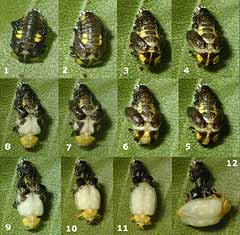
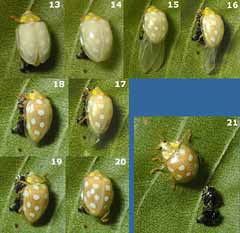
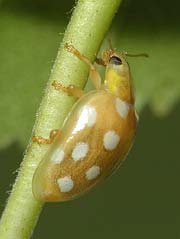
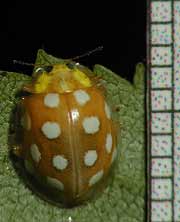
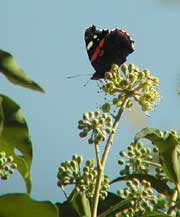
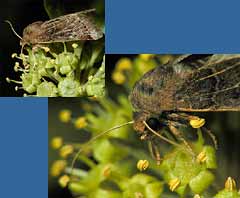
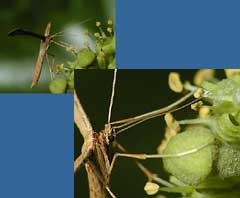
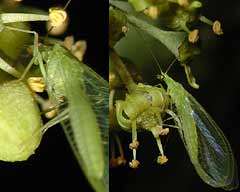
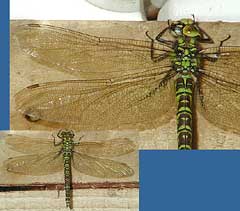

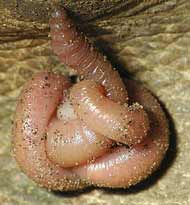
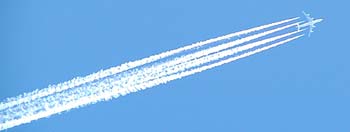 24
September - Another cloudless
start to the day with the only interruptions to the blue caused by the
contrails of the aircraft that criss-cross the sky above us.
24
September - Another cloudless
start to the day with the only interruptions to the blue caused by the
contrails of the aircraft that criss-cross the sky above us.